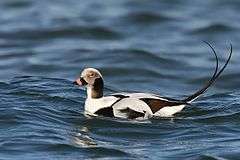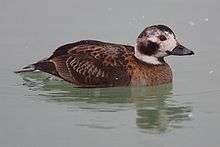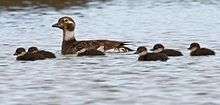Long-tailed duck
| Long-tailed duck | |
|---|---|
 | |
| Male | |
| Scientific classification | |
| Kingdom: | Animalia |
| Phylum: | Chordata |
| Class: | Aves |
| Order: | Anseriformes |
| Family: | Anatidae |
| Subfamily: | Merginae |
| Genus: | Clangula Leach, 1819 |
| Species: | C. hyemalis |
| Binomial name | |
| Clangula hyemalis (Linnaeus, 1758) | |
| Synonyms | |
|
Genus: Species: | |
The long-tailed duck (Clangula hyemalis), once known as oldsquaw, is a medium-sized sea duck. It is the only living member of its genus, Clangula. This was formerly used for the goldeneyes, with the long-tailed duck being placed in Harelda, but the latter is the type species of the genus.[2] An undescribed congener is known from the Middle Miocene Sajóvölgyi Formation (Late Badenian, 13–12 Mya) of Mátraszőlős, Hungary.[3]
Description


Adults have white underparts, though the rest of the plumage goes through a complex moulting process. The male has a long pointed tail (10 to 15 cm (3.9 to 5.9 in) long) and a dark grey bill crossed by a pink band. In winter, the male has a dark cheek patch on a mainly white head and neck, a dark breast and mostly white body. In summer, the male is dark on the head, neck and back with a white cheek patch. The female has a brown back and a relatively short pointed tail. In winter, the female's head and neck are white with a dark crown. In summer, the head is dark. Juveniles resemble adult females in autumn plumage, though with a lighter, less distinct cheek patch.
| Standard Measurements[4][5] | |
|---|---|
| length | 440–600 mm (17.5–23.5 in) |
| weight | 740 g (1.63 lb) |
| wingspan | 710 mm (28 in) |
| wing | 209–228 mm (8.2–9.0 in) |
| tail | 165–237 mm (6.5–9.3 in) |
| culmen | 26–30 mm (1.0–1.2 in) |
| tarsus | 34–38 mm (1.3–1.5 in) |
The males are vocal and have a musical yodelling call ow, ow, owal-ow.
Ecology
Their breeding habitat is in tundra pools and marshes, but also along sea coasts and in large mountain lakes in the North Atlantic region, Alaska, northern Canada, northern Europe, and Russia. The nest is located on the ground near water; it is built using vegetation and lined with down. They are migratory and winter along the eastern and western coasts of North America, on the Great Lakes, coastal northern Europe and Asia, with stragglers to the Black Sea. The most important wintering area is the Baltic Sea, where a total of about 4.5 million gather.
The long-tailed duck is gregarious, forming large flocks in winter and during migration. They feed by diving for mollusks, crustaceans and some small fish. Although they usually feed close to the surface, they are capable of diving to depths of 60 m (200 ft).
Name
In North American English it is sometimes called oldsquaw, though this name has fallen out of favour under influence of negative connotations of the word squaw in English usage. Some biologists have also feared that this name would be offensive to some Native American tribes involved in the conservation effort.[6] The American Ornithologists' Union stated that "political correctness" was not sufficient to change the name, but "to conform with English usage in other parts of the world", it officially adopted the name "Long-tailed Duck".[7] The scientific name is derived from Latin clangere, "to resound", and hyemalis, "of winter".[2]
 |
Long-Tailed Duck
Long Island, NY, March 2007. By Tony Phillips. |
| Problems playing this file? See media help. | |
Status
The long-tailed duck is one of the species to which the Agreement on the Conservation of African-Eurasian Migratory Waterbirds (AEWA) applies.
.jpg)
References
- ↑ BirdLife International (2012). "Clangula hyemalis". IUCN Red List of Threatened Species. Version 2013.2. International Union for Conservation of Nature. Retrieved 26 November 2013.
- 1 2 Jobling, James A (2010). The Helm Dictionary of Scientific Bird Names. London: Christopher Helm. pp. 110, 197. ISBN 978-1-4081-2501-4.
- ↑ Gál, Erika; Hír, János; Kessler, Eugén; Kókay, József (1998–1999). "Középsõ-miocén õsmaradványok, a Mátraszõlõs, Rákóczi-kápolna alatti útbevágásból. I. A Mátraszõlõs 1. lelõhely" [Middle Miocene fossils from the sections at the Rákóczi chapel at Mátraszőlős. Locality Mátraszõlõs I.] (PDF). Folia Historico Naturalia Musei Matraensis (in Hungarian). 23: 33–78.
- ↑ Godfrey, W. Earl (1966). The Birds of Canada. Ottawa: National Museum of Canada. p. 72.
- ↑ Sibley, David Allen (2000). The Sibley Guide to Birds. New York: Knopf. p. 97. ISBN 0-679-45122-6.
- ↑ Though squaw originated as a word simply meaning "young woman" in the Massachusett and related Algonquian languages, it is now considered offensive by many Native Americans and is so labelled in modern dictionaries.
- ↑ American Ornithologists' Union (2000). "Forty-second supplement to the American Ornithologists' Union Check-list of North American Birds". The Auk. 117: 847–858. doi:10.1642/0004-8038(2000)117[0847:fsstta]2.0.co;2.
External links
| Wikimedia Commons has media related to Clangula hyemalis. |
| Wikispecies has information related to: Clangula hyemalis |
- "Long-tailed duck media". Internet Bird Collection.
- Long-tailed duck photo gallery at VIREO (Drexel University)
- Feathers of Long-tailed Duck (Clangula hyemalis)
- Interactive range map of Clangula hyemalis at IUCN Red List maps
